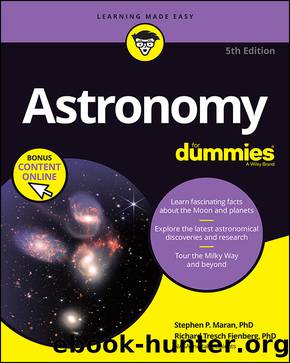Astronomy for Dummies by unknow

Author:unknow
Language: eng
Format: epub
Publisher: John Wiley & Sons, Incorporated
Published: 2023-05-29T00:00:00+00:00
Solar CSI: The mystery of the missing solar neutrinos
The nuclear fusion at the heart of the Sun does more than change hydrogen into helium and release energy in gamma rays to heat the whole star. It also releases enormous numbers of neutrinos, or electrically neutral subatomic particles that have almost no mass, travel at nearly the speed of light, and can pass through almost anything. Astronomers can check on the calculated temperature and density in the core of the Sun by observing neutrinos that come from the star.
A neutrino is like a hot knife through butter: It easily cuts through. In fact, neutrinos can fly right out from the center of the Sun and into space. Those that head Earthward fly right through the planet and out the other side. But the neutrino is different from the hot knife, because the knife melts the butter that it contacts. The neutrino just whooshes through without affecting the matter it touches in almost (but not quite) every case.
Physics experiments can detect the rare exceptions in which neutrinos do interact with matter, so a tiny fraction of the solar neutrinos that pass through huge underground laboratories known as neutrino observatories do get counted. These observatories are located mostly in deep mines and tunnels under mountains. At such depths, few other kinds of particles fly around, so scientists have an easier time telling a solar neutrino from other particles. One major facility, SNOLAB near Sudbury, Ontario, Canada, sits 6,800 feet below Earthâs surface. Itâs a good place to âdelve deeplyâ into astronomy.
Counting neutrinos isnât easy, but in the late 20th century, reports from the neutrino observatories indicated a deficiency in solar neutrinos: The number of neutrinos coming to Earth was significantly fewer than the number scientists expected, based on the rate at which the Sun generates energy.
The solar neutrino deficiency was the least of our problems on Earth. But the loss nagged at scientists, prompting them to make new theories of particle physics and to double-check their theoretical models of the solar interior.
Fortunately, scientists at Sudbury and at underground neutrino observatories elsewhere solved the problem of the missing neutrinos. It turns out that some of the neutrinos produced in the Sunâs core change to either of two other types of neutrinos on the way to Earth, and earlier neutrino observatories, which reported the solar neutrino deficiency, couldnât detect the two other types. The problem was that our ignorance of how neutrinos behave led to deficiencies in the design and capabilities of the laboratory equipment. It was not, after all, a misunderstanding of how the Sun generates energy or how many neutrinos it emits. Hereâs a good analogy: Suppose you count birds for a wildlife survey, but you wear eyeglasses with colored lenses. The colored glasses make it difficult to see birds of certain colors, so you may think bluebirds are endangered, but the problem is that you can see only cardinals.
Download
This site does not store any files on its server. We only index and link to content provided by other sites. Please contact the content providers to delete copyright contents if any and email us, we'll remove relevant links or contents immediately.
| Aeronautics & Astronautics | Astronomy |
| Astrophysics & Space Science | Comets, Meteors & Asteroids |
| Cosmology | Mars |
| Solar System | Star-Gazing |
| Telescopes | UFOs |
Turbulence by E. J. Noyes(7058)
Tools of Titans by Timothy Ferriss(6965)
Astrophysics for People in a Hurry by Neil DeGrasse Tyson(4628)
Room 212 by Kate Stewart(4116)
Pale Blue Dot by Carl Sagan(4017)
The David Icke Guide to the Global Conspiracy (and how to end it) by David Icke(3892)
Secrets of Antigravity Propulsion: Tesla, UFOs, and Classified Aerospace Technology by Ph.D. Paul A. Laviolette(3567)
Apollo 8 by Jeffrey Kluger(3205)
Losing the Nobel Prize by Brian Keating(3188)
A Journey Through Divination and Astronomy by Publishing Pottermore(3154)
Goodbye Paradise(2977)
COSMOS by Carl Sagan(2959)
Brief Answers to the Big Questions by Stephen Hawking(2883)
How to Read Water: Clues and Patterns from Puddles to the Sea (Natural Navigation) by Tristan Gooley(2875)
The Five People You Meet in Heaven by Mitch Albom(2851)
The Order of Time by Carlo Rovelli(2728)
How to Read Nature by Tristan Gooley(2668)
A Brief History of Time by Stephen Hawking(2480)
Aliens by Jim Al-Khalili(2387)
